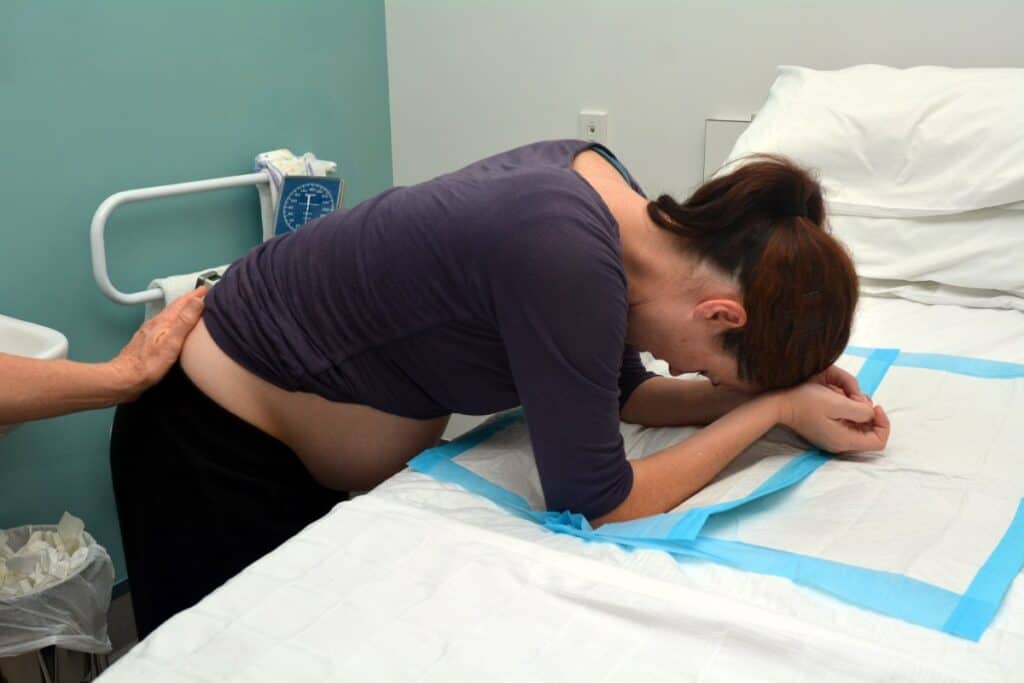Things Your Mom Never Told You About Birth
Birth Mirrors Sex
Two subjects that are too taboo to talk about in polite society – sex & birth – are both part of the same spectrum. Sex and birth mirror one another for a myriad of reasons but the simplest explanation is that they are both part of the same spectrum of sexuality, opposite ends but essentially the same.
I have been in the birth field for decades so naturally my 3 children have been exposed to birth as a very normal part of life. They have watched countless birth videos, explored my birthy props, attended live classes and have more of a grasp on the process than many adults.
I have a confession to make. I am still one of the moms that hasn’t told my kids that sex and birth are two sides of the same vagina-birth canal. (You guys know those are the same thing right? )
Sex & Shame
I have a lot of shame around sex so even though I have made the connections as a birth worker, I still have never said what I am about to say to you, to my own children. Sadly, they still fall into the same category of things your mom never told you about birth.
Full disclosure: I completely failed in the realm of open sex education with my oldest, but I have learned from my mistakes and the emerging tweens now come to me with lots of sex questions. Sometimes it’s awkward, but it is also building trust.
So stay with me while we discuss the beauty of this sexual spectrum that fills humans with pleasure, connection, beauty, passion, creativity and obviously, more humans.

Hormones
Oxytocin, mother of all things juicy, sexy & feminine, is the key hormone in both processes. Oxytocin also has a badass buddy, endorphins, which are your own natural opiates to increase pleasure, decrease pain and induce euphoria. Where oxytocin goes, endorphins follow so we have an awesome cocktail of hormones related to reproduction.
Oxytocin is a contracting hormone; aka the great ejector. Through muscle contraction, she gets out sperm, babies, placentas & human milk. We can see how at the very base physical level, oxytocin promotes birth by contracting the uterus, changing the cervix and pushing your baby down and out while it completes sex by contracting muscles in our sex organs to cause orgasm and ejaculation.
Emotionally, oxytocin is the great connector. It promotes feelings of well-being, pleasure, happiness, bonding and love. During sex, it connects us to our partners by pulsing out increasing levels that bathe us in pleasure and feelings of connection. During birth, it increases feelings of pleasure, engorges and lubricates the birth canal and the highest levels of circulating oxytocin we will ever have connect us with this little soul that just emerged from our bodies.
Birth Mirrors Sex: Oxytocin Edition
OXYTOCIN DURING SEX =
- INCREASES FEELINGS OF PLEASURE & HAPPINESS
- PRODUCES FEELINGS OF BONDING & LOVE WITH YOUR PARTNER
- CAUSES MUSCLE CONTRACTIONS DURING ORGASM
- EJECTS SPERM OUT OF A PENIS
OXYTOCIN DURING BIRTH =
- INCREASES FEELINGS OF PLEASURE & DECREASED PAIN
- PRODUCES FEELINGS OF BONDING & LOVE WITH YOUR BABY
- CAUSES MUSCLE CONTRACTIONS – JUST CALLED “CONTRACTIONS”
- THINS & OPENS THE CERVIX
- PUSHES YOUR BABY DOWN & OUT
Environment
Set the scene:
- dark: dimly lit, maybe flickering candles or fairy lights
- warm: in the room or under blankets
- safe: just your partner & their unconditional love
- music: calm, rhythmic beats
Is this a sex scene or a birth scene? The easy answer is both. The environment that allows oxytocin to flow has all of these qualities so wherever you are on the spectrum, making a baby or birthing a baby, the scene is the same.
*Partner Tips: Your job during birth is to protect the space.

Purity Check
There are many reasons why this entire conversation makes us squirm. It can range from:
- religious beliefs that frame sex as sinful and painful birth as punishment
- learned shame around our bodies and sex organs
- abuse of these sacred parts of our bodies
- hyper sexualization of the female form which makes it hard to see the functional parts of anatomy
- just simple embarrassment about our bodies
- lack of exposure to their natural functions
- misinformation about how our bodies work
- lack of exposure or practice talking about our bodies in a healthy way
There is power in knowing how we are wired. Regardless of your beliefs, this is just biology. Our natural design uses the same hormones to initiate and complete both processes, without judgement or inhibition, just flowing through us, to assist our body’s optimal function. Hormones do not judge!

Positions
Yep, I’m going there. This is not the Kamasutra, just a quick overview of how the mirroring of getting a baby in and getting a baby out is reflected with our body positions.
I teach UFO’s when discussing body positions for optimal birth function – Upright, Forward, Open.
Your goal is to get your baby to navigate your pelvis by making as much space as possible & adding in gravity to help them move through.
Let’s discuss the variations that assist a baby moving down and out, and you can use your imagination as to how those were possibly used to help a baby in.
Just remember that most people associate a bed with just lying immobile, but modern birth beds in hospitals are very convertible – the whole bed can raise and lower, they shift in all sorts of ways – with the top lifted or bottom off, and they allow your body to move into the positions mentioned here.
Get creative, just like with sex – in or out of the bed!
Positions: All 4's
- drops uterus away from the spine to make more space
- eases back pressure/pain
- assists with sacrum mobility
- allows freedom of movement with your hips, swaying side to side, rocking front & back, tucking & untucking your pelvis or spiraling around in small or big circles
- great position through any stage of labor, including pushing


Positions: Side Lying
- resting position
- can promote passive pelvic opening with pillows or peanut balls between your knees/legs (yep, balls between your legs)
- great with an epidural to assist in opening the pelvis and moving side to side when you cannot get upright or use your legs
- nice pushing position that allows the sacrum to move out of the way and make more space for baby to exit
Positions: Squatting
- deep squat opens the pelvic inlet to help your baby get into the top of the pelvis
- higher squat assists with opening the bottom of the pelvis
- upright uses gravity
- you can use a squat bar on the hospital bed
- use blocks, pillows, partners or chairs for support on any squat level
- straddling your partner’s lap or sitting on a birth ball is a supported squat variation
- squat if it feels good


Positions: Standing
- utilizes gravity to help baby descend
- free to move
- slow dancing with partner – front or back
- wide base with your feet to get your hips moving, sway side to side, spiral your hips to make more space in your pelvis
- abdominal lift to assist fetal positioning
- gyrate, shake, shimmy, bounce, tuck, twerk, dance!
- people can push leaning or standing, usually with support
Positions: Asymmetry
- makes more usable space in the pelvis
- use hip gyrations, spirals, tucks or hip bumps
- 1 foot up on a stool (think Captain Morgan)
- curb walking (1 foot up on the curb, 1 foot in the street)
- walking up and down stairs
- small lunges side to side, sitting back in your heels, with support
- low lunge on the ground or in a bed allows a huge pelvic shift
- hip shifts or circles in a low lunge to shapeshift your pelvis
- lean over a birth ball for chest support with 1 leg in a low lunge
- sumo style stomps – lifting 1 leg at a time and sitting low

Positions: Supine
If one of your favorite sex positions is the classic supine missionary position (flat on your back with your legs up), notice I left it off this list. That one is great for getting babies in, but not usually optimal for getting them out regardless of any birth scenes you have witnessed depicting a birth bed at the center of the activity.
Flat or even slightly reclined with your legs up has a few drawbacks on the birth side of things:
- doesn’t utilize gravity to get your baby down – closer to pushing a baby uphill
- legs pulled really far apart mimic a deep squat which closes off the escape hatch for your baby (bottom of the pelvis)
- laying on your sacrum – which is actually a flexible bone that moves – makes it immobile and also makes your baby’s exit more narrow
- it is usually more painful
- as mammals, it feels less safe & more vulnerable
- the only benefit to this position is so the birth provider can position your crotch at the end of the birth bed, pull up a stool and watch the show – of course, if they need to utilize tools, this is useful (assisted vaginal birth is only 1-4% of births)
Just remember that most people associate a bed with just lying immobile, but modern birth beds in hospitals are very convertible – the whole bed can raise and lower, they shift in all sorts of ways – with the top lifted or bottom off, and they allow your body to move into the positions mentioned above. Get creative, just like with sex – in or out of the bed!
Sounds
People make all sorts of sounds during sex…I mean birth. Breathing deeply or in a shallow, fast pattern, panting, low deep guttural sounds that blur the lines of pleasure and pain, higher pitched, repetitive noises, sighing, moaning, cussing, screaming unintelligible words, repeating phrases in a mantra-like fashion, finding a rhythm with a close support person and attuning to one another.
The sounds I am referring to allow your vocal energy to flow out of you versus stifling it inside of you. Think about free, fun, uninhibited romps versus hiding from the kids for a quickie in stealth mode. (Maybe you haven’t experienced this one yet, but you will soon.)
Many people feel a bit embarrassed watching a birth video because it sounds very familiar to sex. The low, deep, primal noises elicited with oxytocin flow relax the pelvic floor and open your body which is exactly what needs to happen during the pushing/releasing phase of labor.

Fluids
Birth is messy! It is accompanied by vaginal mucous, bloody show, amniotic fluid, birth goo covering your baby & sometimes even pee & poop – yours and theirs.
To put it plainly, we generally need to be lubed up to get a baby in and lubed up to get a baby out – it is just a messy, fluid-filled process all around.
Refractory Period
Take a few deep breaths, in through your nose, relax your jaw, let it flow out of your mouth.
I know this information can seem a little crazy at first. Adults are very familiar with one side of the spectrum, the sex side, while the birth side of the spectrum is mostly foreign.
Hopefully, you will just realize that you are actually more prepared for birth than you thought because you have already been practicing for it with your breath and body.
There are also innovative reproductive technologies that allow babies to take root in us without some of the biological processes discussed here. However a baby arrives in your womb, you have the skills to get it out. Enjoy the practice!
Remember that in order to keep the oxytocin flowing, the environment must be protected, so grab some flameless candles, make a playlist, buy a birth ball and get moving in your safe, protected sex den, I mean, birthing space.
